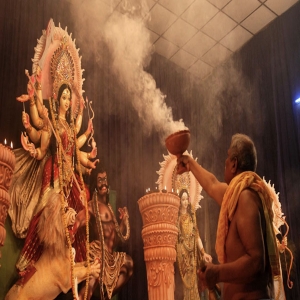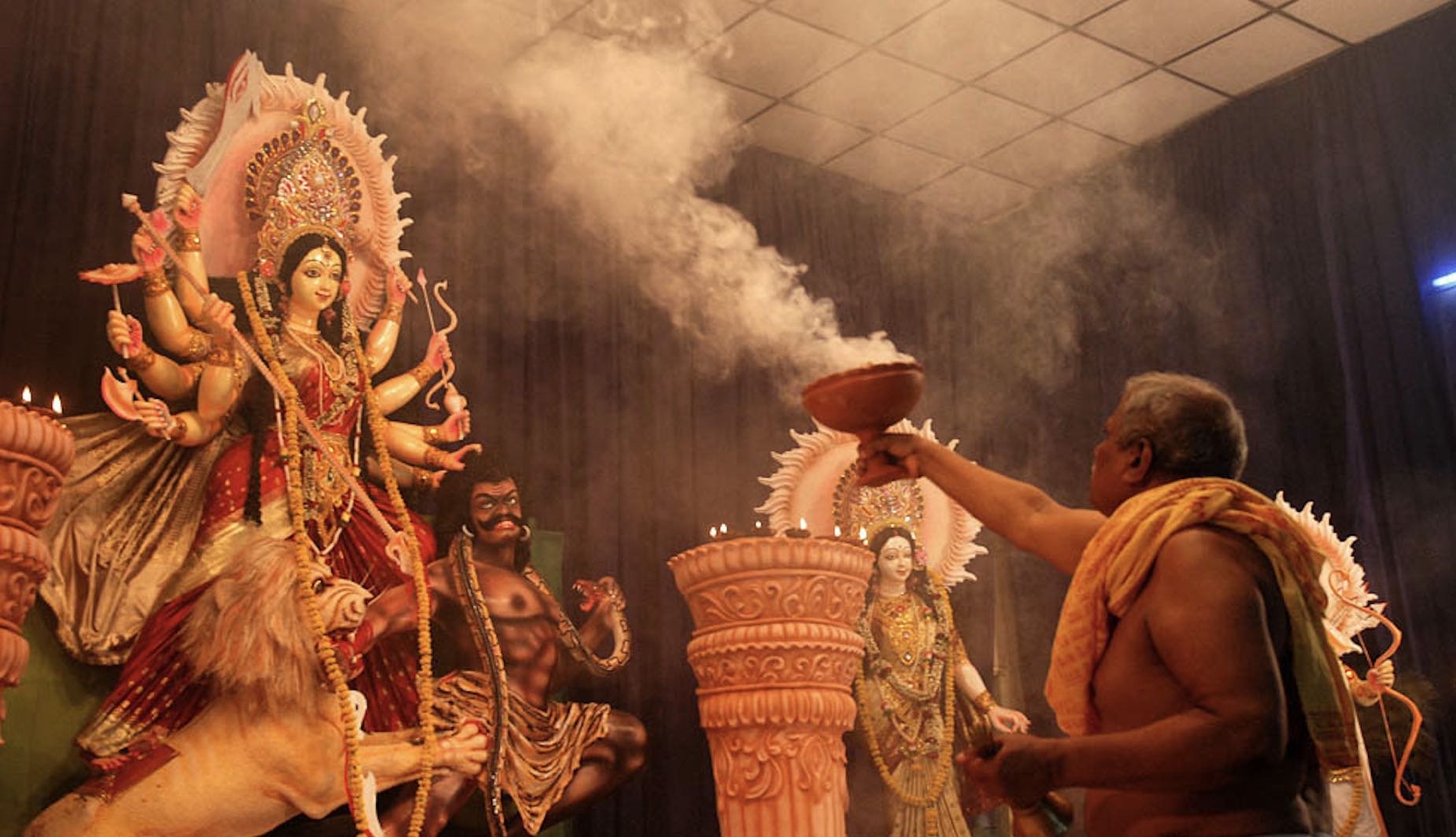

As Bengal prepares for Durga Puja, the streets of Siliguri, Kolkata, and Krishnagar begin to hum. There is a familiar rhythm of clay being moulded, pandals rising, and communities gathering. Durga Puja is no mere festival; in West Bengal, it is a civilisational heartbeat. It is a sacred season where devotion meets artistry, and community becomes communion.
The Goddess as Mirror and Warrior
Durga, the ten-armed goddess, is not simply a mythic warrior from ancient lore. She is Shakti, the living embodiment of divine feminine energy that confronts chaos, injustice, and moral paralysis. Her descent each year is a spiritual summons: to name evil, resist it, and restore balance—not only in scripture, but in the soul of society.
In a time when violence is normalised, truth is muffled, and fear is politicised, Durga's image becomes a mirror. She reflects not just our aspirations, but our complicity. Her raised weapons are not symbols of vengeance but reminders of vigilance.
She calls us to confront the Mahishasuras of our time: corruption, casteism, communal hatred, gender violence, and ecological destruction. "She didn't just slay Mahishasura," says a young sculptor in Ghurni, giving final touches to a Durga statue. "She slays our despair, our fear, our silence."
In the hands of Bengal's artisans, Durga is not frozen in mythology—she is reimagined as a mother, a migrant, a protester, a healer. Her face carries the anguish of the oppressed and the defiance of the prophetic. She is not distant; she is dangerously close to our conscience. To worship Durga is to awaken. To carry her idol is to hold her courage. And to immerse her in the river is to recommit ourselves to the struggle she embodies.
Art as Worship, Worship as Public Culture
The spiritual core of Durga Puja is inextricably linked to its cultural grandeur. It is not confined to temple rituals or private devotion. It spills into the streets, into sculpture, sound, and spectacle. UNESCO's 2021 recognition of Kolkata's Durga Puja as an Intangible Cultural Heritage of Humanity affirms that art is worship, and worship is public. Every brushstroke, bamboo frame, and rhythmic drumbeat becomes an offering.
From Kumartuli's clay idols, sculpted with riverbed soil and ancestral memories, to pandals that mimic temples, trains, refugee camps, or global landmarks, Durga Puja is a canvas of collective creativity, where theology meets theatre and civic imagination becomes a sacred space.
Here, artisans are theologians. Their hands preach what pulpits cannot. Their installations provoke questions that politics tends to avoid. A pandal may resemble a South Indian temple, a Himalayan monastery, or a collapsing glacier—each telling a story of faith, fragility, and resistance. In this way, Durga Puja becomes Bengal's most eloquent form of public theology: a liturgy of light, labour, and longing.
To walk through a pandal is to walk through a sermon. To behold the goddess is to behold our own contradictions. And to celebrate her is to recommit ourselves to beauty, justice, and shared belonging.
Sacred Hands, Silent Prayers
For Bengal's statue makers, Durga Puja is a sacred vocation rooted in ancestral memory and spiritual labour. These artisans, working in cramped studios along the lanes of Kumartuli or suburban workshops in Krishnanagar, do not just shape clay; they shape consciousness. Their hands carry centuries of tradition, transforming riverbed soil into divine presence and silence into sculpture.
In a time when religion is increasingly mediated by spectacle, branding, and mass production, Bengal's idol makers remind us that devotion begins with touch—with the slow, reverent act of creation. "Durga Puja is not just a festival—it's our sacred season of creation," says Subrata Ganguly, Bengali Brahmin and CEO of Church Art Kolkata, which supplies religious statues across India. "For statue makers, it is the time when clay becomes divinity, and craftsmanship becomes worship. Every idol we sculpt carries the emotion of millions, the legacy of generations, and the silent prayer of the artisan's hand."
These artisans are often invisible in the final celebration—rarely named, seldom honoured. Yet their work is prophetic. In each curve of Durga's brow, each gesture of her hand, they embed stories of struggle, resilience, and hope. Many come from marginalised castes and communities, yet they are entrusted with the sacred task of giving form to the goddess herself.
Their vocation is an affirmation that the divine can dwell in the humble, that beauty can arise from labour, and that worship is not confined to temples but begins in the workshop. In their hands, religion is not a commodity but a communion.
From Zamindars to the People
But Durga Puja is more than a spectacle. It is a stage for social solidarity. Historically, a zamindari ritual, it became a people's festival through the Baroyari movement.
The Barowari movement, rooted in the spirit of "baro-yaari" or "twelve friends," began in 1790 when a group of young men from Guptipara in Hooghly district organised a communal Durga Puja. When people became suspicious, it was opened to the public—breaking away from the zamindari tradition of private, aristocratic worship.
This laid the foundation for what is now known as Sorbojanin—a festival "for all people." By the early 20th century, especially during the Swadeshi movement, Barowari Puja evolved into a platform for nationalist mobilisation, with pandals showcasing freedom fighters, anti-colonial themes, and indigenous art. It democratised religious space, transforming Durga Puja into a civic ritual where faith, creativity, and political consciousness could converge.
Faith Without Borders
In an age when religious identities are weaponised and communities are increasingly polarised, Durga Puja in Bengal offers a counter-witness—an inclusive space where faith becomes fellowship. The festival draws in Hindus, Christians, Muslims, Sikhs, Buddhists, and atheists alike, not through dogma but through shared devotion, artistry, and celebration.
Volunteers, artisans, sponsors, and devotees co-create the experience, blurring lines of caste, class, and creed. In pandals and processions, one sees hijab-clad women arranging flowers, Christian youth managing sound systems, and tribal elders offering prayers alongside Brahmin priests. "Durga Puja is our shared prayer," says an Adivasi catechist in Jalpaiguri. "Even if our gods differ, our longing is the same."
A Counter-Narrative of Hope
Politically, Durga Puja has long been a site of resistance. Revolutionaries used the gatherings to distribute pamphlets, raise funds, and celebrate heroes. The goddess herself was reimagined as Bharat Mata—a symbol of a motherland under siege, inspiring poets, freedom fighters, and cultural reformers to reclaim India's dignity.
But resistance did not end with independence. Durga Puja continues to offer a quiet but potent counter-narrative. It is a space where art becomes protest, and ritual becomes reflection. Pandal themes now speak to ecological crisis, gender justice, and constitutional values. Clubs have depicted farmers' struggles, refugee journeys, and even the plight of manual scavengers—challenging viewers to confront uncomfortable truths.
Durga Puja reminds us that faith can be prophetic. Worship need not be submissive—it can be subversive.